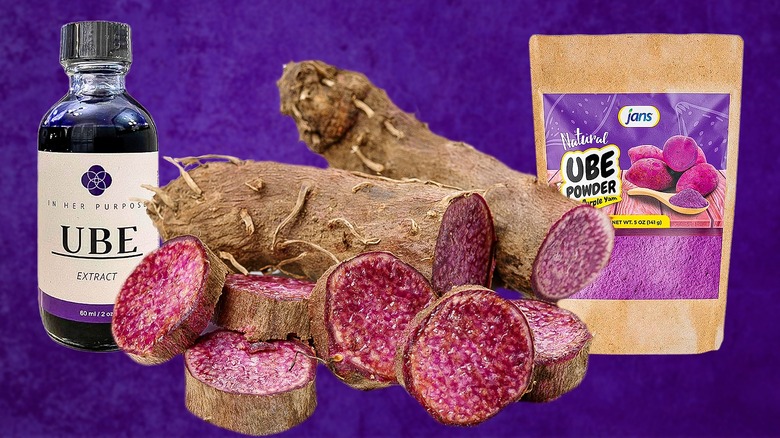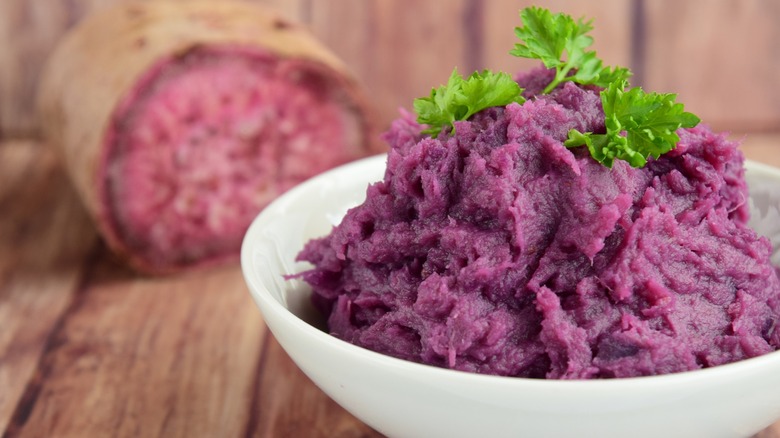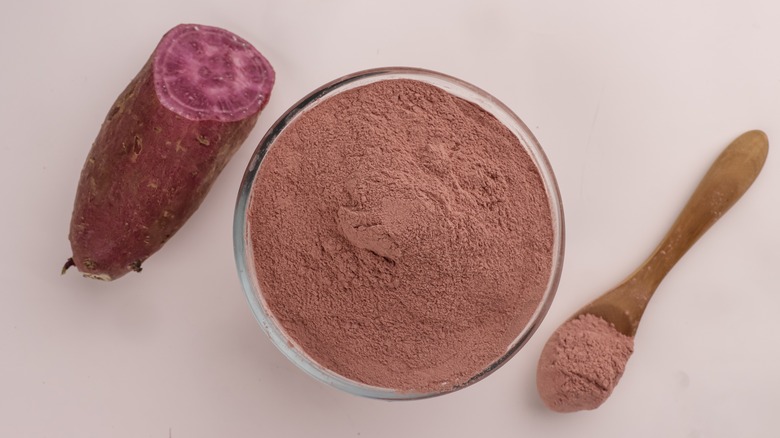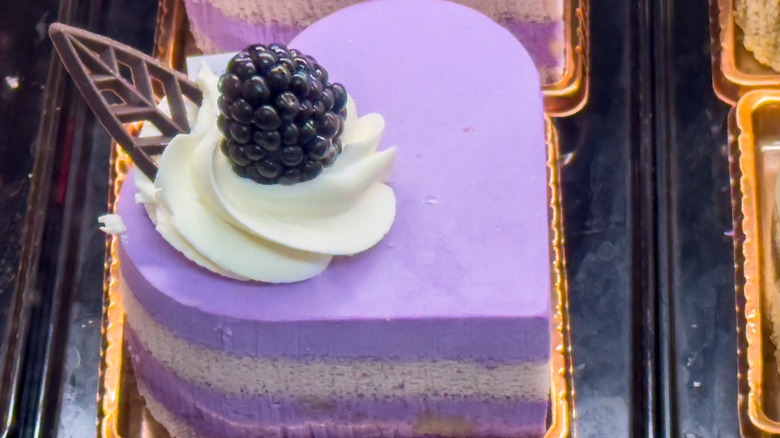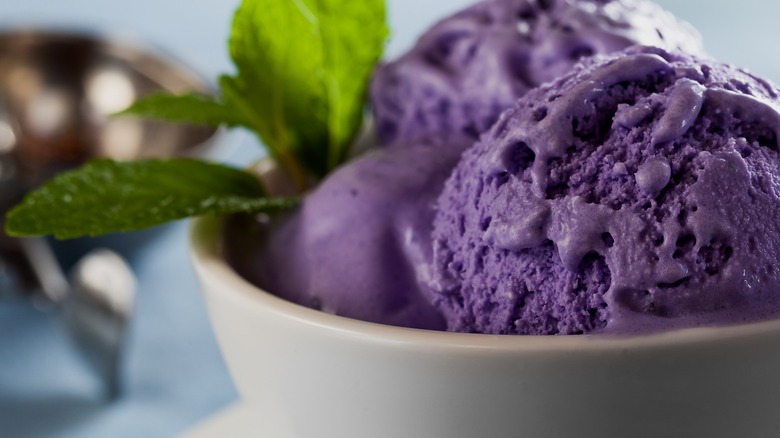Ube Extract Vs Powder: What's The Difference?
We may receive a commission on purchases made from links.
Although ube (pronounced ooo-beh) has been an integral part of Filipino cuisine for at least 400 years, the vibrant root vegetable has really taken off in the past few years as a trendy ingredient in the U.S. You can now find everything from ube-flavored pretzels at Trader Joe's to donuts and cookies made with the bright purple yam at mainstream coffee shops. But if you want to try recreating some of these treats at home, incorporating ube into your baked goods and beverages is a great place to start.
However, you don't have to track down fresh ube (which can be tough to do outside of its native Southeast Asia) every time you want a dessert or latte made with its unique flavor and color. You have a few other options, mainly buying either an extract or powder that uses its essence. However, these two ingredients aren't completely interchangeable. Since baking is such an exact process, you'll want to have a good understanding of the differences between ube extract and ube powder before getting started. Not only are they made differently, but you'll want to deploy each one in a certain way, and only in specific treats.
What is ube extract?
A bottle of ube extract, such as this one by Butterfly on Amazon, will look very similar to other types of extract that you may be more familiar with, like vanilla or almond. Of course, ube extract is made from the root vegetable, and is meant to insert the same flavor (sweet and slightly nutty) and color (purple) into anything it's added to. However, since it's more concentrated, this liquid may actually make your baked goods brighter than they would be if you used fresh ube. Just like with vanilla extract, you typically only need a small amount of it — a few drops, really — to accomplish this.
The ingredients in ube extract vary a little, but you'll see plenty of similarities across different brands. Generally, glucose syrup is first on the list, followed by flavorings, coloring, and an alcoholic component. To make the final product, ube harvesters start by following a process similar to making mashed potatoes. They'll boil the vegetables until they're soft, mash them up, and then pull out the liquid by either pressing or filtering the purée. From there, the extract is distilled down even further before it's bottled. And while this process results in containers with natural ube flavor, there are some brands that use artificial flavoring and coloring instead.
What is ube powder?
Unlike ube extract, ube powder is often made solely from the purple yams themselves. You may also see it called purple yam powder, but these products are the same thing. Because it doesn't contain fillers or other ingredients, it's typically gluten free and vegan. When you use it, you'll be completely relying on the root vegetable for that purple color. This means that it may be a little more muted than the hue you'd get with ube extract, which often includes artificial food coloring. To make this form of ube, manufacturers follow a process that starts out similar to creating an extract.
They'll cook and mash the yams, then dry them out and pulverize them until they form a powder. As a result, this product on its own has a grainy consistency. Since it's dried out, however, you don't need to refrigerate it, and it can last for up to six months in your pantry. If you're on the lookout for an alternative to fresh ube, it may be easier to find this powdered version than to track down the extract. You'll typically see it at Asian groceries and specialty food stores — but if you're not finding it there, plenty of brands also sell it online, including this Jans ube powder available on Amazon.
Use ube extract when consistency matters
If you want a vivid purple hue and a distinct yam flavor in your final product, ube extract is an ideal ingredient to try out. It's easy to start small and add in more drops if you want a more potent result. But in general, you can sub it in for vanilla extract at a 1:1 ratio. Just like vanilla extract or food coloring, this ube-based product is ideal for treats where you want a smooth consistency. For example, it's the best way to make an ube latte. All you need to do is mix a few drops into your milk of choice, then add in the espresso.
And if you want to make any other beverages with a thin consistency, such as cocktails, this extract is an easy way to add a pop of purple to your drink. If you're looking to bake with ube, on the other hand, you can just squeeze a few drops into the wet ingredients of your recipe. Feel free to use it for basic treats like brownies and cookies, or fancier ones like frosting and pudding. While it will alter the color and flavor of your dessert slightly, this addition is small enough that it shouldn't change its texture.
Make ube powder into a paste or use it as-is
If you're not concerned with creating a silky-smooth consistency, you may want to opt for ube powder instead. But unlike the extract, you don't want to just dump this product into your recipe. Instead, mix it with water and turn it into a paste to avoid any graininess. To do this, use 2 cups of water for every 6 tablespoons of the powder, and heat both components up together on medium low over the stove. It should only take a couple minutes of constant stirring for the two to meld together and form a paste. From there, you can use your new ube mixture to thicken treats like smoothies, milkshakes, and ice cream.
However, it's also possible to use this powder without making it into a paste. You can stir it into the dry ingredients for recipes like cookies and cake, where it will bring its color, flavor, and slightly grainy texture. The amount you use will vary by recipe, but it usually ranges from a few tablespoons to ⅓ cup. Finally, for an easy (and pretty) way to incorporate ube powder into a dessert, simply deploy it as a replacement for dusted powdered sugar by sprinkling it over croissants, pancakes, and French toast. However you choose to use it, the anthocyanin-rich ube is a nutritious addition to your treats.
